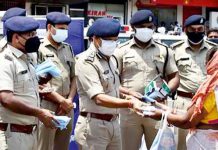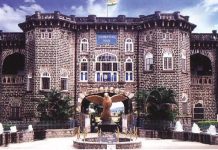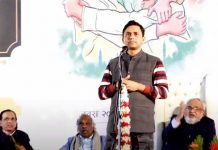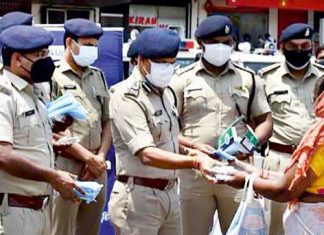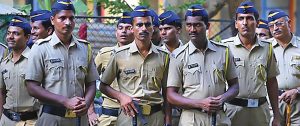 After a spate of attacks on the police officers by the members of public, the state has been in a state of dilemma that while we have cops to protect us, cops do not have anybody to protect them. The safety of the man in khaki has become a matter of concern for the home department.
After a spate of attacks on the police officers by the members of public, the state has been in a state of dilemma that while we have cops to protect us, cops do not have anybody to protect them. The safety of the man in khaki has become a matter of concern for the home department.
We live in a country where law & enforcement is given utmost respect since they define the boundaries that the citizens have to follow. And if any boundary is crossed we are penalized. The police department in charge of law enforcement is continuously working towards maintaining law & order. For the law abiders they are saviors, but for the lawbreakers they are a stumbling block.
Officially, the police force is constituted of persons empowered by the state to enforce law, protect the property and limit the civil disorder. In a layman’s term their job is to enforce laws, help in emergencies, solve crime and to deal with criminals.
The Maharashtra police logo consists of a hand of trust with a line stating “Sadrakshnaya Khalanighrahanaya” which means“ to protect good and to punish evil”. Though we expect proper compliance of law in the state most of us can’t imagine the difficulties that they undergo to keep us safe and secure.
In recent times, there have been several instances where policeo fficers have been attacked compelling us to think about their safety rather than about our safety for which they have been recruited. During the budget session in March, the chief minister- Devendra Fadnavis informed the Legislative Assembly that a total of 202 cases of assault on policemen were registered in 2014 and 284 in 2015 indicating an increase in the number of such cases.
Attacks on police officers this year
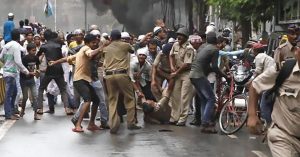 The Maharashtra police have witnessed back to back attacks on their officials while on duty in recent times. The attacks have definitely raised a question about the safety and security of the man in Khaki.
The Maharashtra police have witnessed back to back attacks on their officials while on duty in recent times. The attacks have definitely raised a question about the safety and security of the man in Khaki.
On August 12, during a regular police check post (Naka- Bandi) a woman constable was threatened by a biker who was allegedly stopped for rash driving. The accused was later arrested by the city police for misbehaving and stopping public servant from conducting his duty.
At Pimpari, a person arrested for a crime attacked himself with a blade and also attacked the police officer who tried to stop him.
In an another incident on August 25, constable Shinde was on duty near the petrol pump, collecting details of motorists. He stopped a young boy who was riding a bike. The boy got into an argument with Shinde, telephoned his older brother, who rushed to the spot and hit the constable on the back of the head with a stick. Shinde collapsed and the brothers fled, but were arrested within 24 hours. Nine days later, traffic head constable Vilas Shinde, 51, died in the intensive care unit of Lilavati Hospital at Bandra (west).
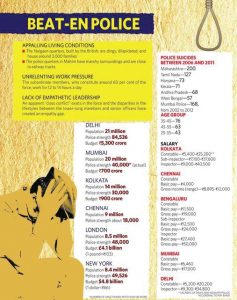 In the month of September, a police officer was hit by a fast bike while he was attempting to stop him during a police naka- bandi. The accused in the case was taken to police station and left after filing a NC and warning. In yet another case, a police officer who intervened to settle a dispute between the two groups was beaten up by one of the group members. The video which was captured by a citizen was later forwarded on social media after which the cops swung into action and filed a case against 145 people.
In the month of September, a police officer was hit by a fast bike while he was attempting to stop him during a police naka- bandi. The accused in the case was taken to police station and left after filing a NC and warning. In yet another case, a police officer who intervened to settle a dispute between the two groups was beaten up by one of the group members. The video which was captured by a citizen was later forwarded on social media after which the cops swung into action and filed a case against 145 people.
Similarly, on September 05, during a bandobast at Lalbaug, a police officer was manhandled by a person. The victim officer was pushed and threatened. Cops failed to register any complaint.
September 06 -Hat-trick attack day
In the afternoon on September 06, an on duty lady constable was beaten up by a woman who was stopped for not wearing a helmet. The woman later assaulted the constable and beat her up. On the same day, at Nashik during a naka- bandi a police officer was hit by an auto driver during an attempt to stop him. Thankfully, the police officer was not injured and the auto driver was booked for rash driving and relevant section of Indian Penal Code. In an another incident on the same day a cop from Kalyan’s Kolsewadi was attacked by four people while he was helping others with Ganpati Visarjan.
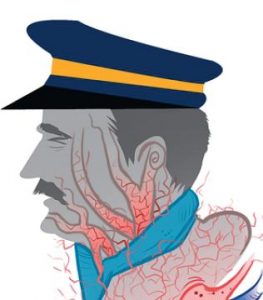 Ganpati immersions were to take place at Tisgaon Lake, Kalyan (east). Since the lake belongs to the gram panchayat and is not a civic property, the villagers raised an objection to immersions. As aresult, all the Ganpati idols, which were brought for immersions, both of mandals (public) and house holds (private) were stopped.
Ganpati immersions were to take place at Tisgaon Lake, Kalyan (east). Since the lake belongs to the gram panchayat and is not a civic property, the villagers raised an objection to immersions. As aresult, all the Ganpati idols, which were brought for immersions, both of mandals (public) and house holds (private) were stopped.
This led to overcrowding and at around 9 pm some residents requested the cops, who were manning the crowd to let them immerse their household idols.
“At that time, PSI Dagale took the lead and came forward to help them with the immersion,” said a Kolsewadi cop.
This angered the members of Jarimari Mitra Mandal, who were also waiting to immerse their Ganpati. One of the four attackers pushed Dagale into the lake and tried to drown him by sitting on his shoulders.
The police, later, registered a case against the four unknown people under sections 34, 183, 307, 323, 332, and 353 of the Indian Penal Code (IPC). “We do not know their names but their faces are visible on a video which was shot by someone from the public,” said a senior police official from Kolsewadi police station
Health Issues
Health of policemen has always been a matter of concern for the police department. The prolonged work hours take a toll on both their physical and mental health. According to the police department and mental health experts it is not sheer impulse that compels a person to end his/her life. There are several factors that develop and grow over a period of time that compel a person to take such a drastic step. A person takes this extreme step only when the line is crossed and the stress is unbearable.
In a report on suicides by policemen, it was found that police personnel aged between 35-45 led the list, with 76 of them ending their lives between 2006 and 2011, followed by police personnel in the age group of 45-55 with 63 suicides and 43 personnel ending their lives in the age group of 25-35.
In 2011, Tamil Nadu reported over 31 suicides, while Maharashtra recorded 27. Still, Maharashtra topped the list with 200, followed by Tamil Nadu (127), Haryana (73), Kerala (71), Andhra Pradesh (68) and West Bengal (57) from 2006 to 2011.
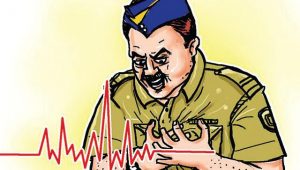 City-based psychiatrist Dr. Harish Shetty, who organized workshops for the police, found that long working hours, poor work conditions, VIP protection duty, festivals and lack of structural reforms had increased stress levels among police personnel. Long term stress causes depression and suicide, he explained. Regular screening for mental health problems during a physical checkup is a must, he felt. “During the workshop, I found that there is an increase in personnel committing suicide in India. Depression across age groups in the force is not easily identified and fixed early, leading to such drastic steps, not to forget the easy availability of lethal weapons with police personnel,” said Dr. Shetty in a daily newspaper.
City-based psychiatrist Dr. Harish Shetty, who organized workshops for the police, found that long working hours, poor work conditions, VIP protection duty, festivals and lack of structural reforms had increased stress levels among police personnel. Long term stress causes depression and suicide, he explained. Regular screening for mental health problems during a physical checkup is a must, he felt. “During the workshop, I found that there is an increase in personnel committing suicide in India. Depression across age groups in the force is not easily identified and fixed early, leading to such drastic steps, not to forget the easy availability of lethal weapons with police personnel,” said Dr. Shetty in a daily newspaper.
Former IPS officer- turned-lawyer Y. P.Singh attributes excessive work pressure and failure to accomplish desired professional ambitions as primary or major contributory reason for suicides. Such ambitions could be like getting good postings or desire for career advancement. “Work pressure could be one of the causes but the greater one is the humiliation by seniors in the form of day to-day harassment or punitive transfers and punishment posting for a good officer for many years. Such unbearable humiliation and consistent mental torture foster suicidal tendencies,” said Singh.
He said it was necessary to ensure that police personnel do not turn skeptical when “some” officers continuously get good postings, whereas good ones get relegated. “This leads to discrimination and ridicule in social circles; wives and children of successful officers often boast, which humiliates kins of those in bad postings. This makes a sensitive officer vulnerable to suicide. The best way is to ensure that postings and transfers are transparent, with an unbiased committee, and based on sound principles of job rotation,” he said.
Statistics
Of the 149 policemen that died in 2014, 38 (over 25%) succumbed to heart disease, reveals the cause of death data provided by the Mumbai police. In the current year, 13 policemen in service have died due to heart attack. After heart attack, unnatural deaths are the most common causes of death in the police force.
“Unnatural death includes all those categories where death does not occur due to an illness. A person may die an unnatural death as he becomes a victim of assault or may be caught in a cross fire or be killed,” said a doctor from Nagpada police hospital. 28 policemen died an unnatural death last year. The policemen are also plagued with illnesses that last for years and may be terminal, such as cancer or HIV. Around 27 policemen died of terminal illnesses. While twelve policemen died of liver ailments, ten succumbed to tuberculosis last year.
Three policemen committed suicide in 2014. This year until May, another three committed suicide, the latest case being that of assistant sub-inspector with Vakola police station, Dilip Shirke, who shot himself after killing his senior Vilas Joshi.
According to doctors at Nagpada police hospital, stress and strain plagues the police force compelling them to take such drastic steps.
“Policemen, especially in the lower rungs, often have duty stretching to 48 hours. There is no facility for them to have a proper meal. They sustain themselves on junk food such as vada pav. They go through stress as there are no weekly offs. If there is bandobast duty, they have to sacrifice their leave and report to work,” said a doctor at Nagpada Hospital.
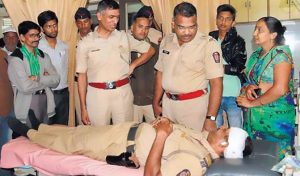 These problems have plagued the Mumbai police since years and they are aware of it. This is the reason in 2010, Mumbai police started 21 gymnasiums covering 91 police stations. “The gyms are operational and more policemen should take advantage of the services available to them,” said a spokes person of Mumbai police. “In the last seven years, a healthcare programme for policemen has been devised. The healthcare plan offers cashless healthcare services in leading private hospitals like S.L. Raheja in Mahim and Bombay Hospital in Marine Lines,” the officer added.
These problems have plagued the Mumbai police since years and they are aware of it. This is the reason in 2010, Mumbai police started 21 gymnasiums covering 91 police stations. “The gyms are operational and more policemen should take advantage of the services available to them,” said a spokes person of Mumbai police. “In the last seven years, a healthcare programme for policemen has been devised. The healthcare plan offers cashless healthcare services in leading private hospitals like S.L. Raheja in Mahim and Bombay Hospital in Marine Lines,” the officer added.
Activists, however, argue that the underlying problem is the issue of staff shortage in the police force. Up to 12,000 police posts are lying vacant in the entire state, said a RTI activist Anil Galgali, who has written a letter to chief minister Devendra Fadnavis regarding the issue.
Over 300 constables in the south zone were included in a study conducted last year by Apollo clinic in Colaba, which revealed that 51 percent of them were overweight by at least ten kgs. Also up to 68% of them had high blood pressure, paving the way to subsequent heart disease. Also, 72% had abnormal kidney or liver function which was detected through ultrasonography.
Mumbai Police Healthy Heart Programme
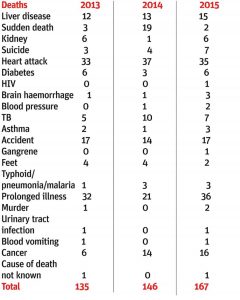 With heart ailments on the rise among members of the Mumbai police force, the Maharashtra government is set to introduce the ‘Mumbai Police Healthy Heart Program,’ under which 5,000 members of the Mumbai police will be screened for heart ailments. They will also be provided treatment for free if their test reports are positive, said a senior official from state home department. chief minister Devendra Fadnavis will launch the program.
With heart ailments on the rise among members of the Mumbai police force, the Maharashtra government is set to introduce the ‘Mumbai Police Healthy Heart Program,’ under which 5,000 members of the Mumbai police will be screened for heart ailments. They will also be provided treatment for free if their test reports are positive, said a senior official from state home department. chief minister Devendra Fadnavis will launch the program.
Currently, the program is exclusively for members of the Mumbai police but will be extended to police personnel across Maharashtra, depending on its feasibility, said the officer. Data obtained from the Mumbai police shows that 78 police personnel including police officers have succumbed to heart attacks since 2014. In 2014, one in four policemen succumbed to a heart attack. The state government has roped in the Asian Heart Institute, which will train 1,000 police personnel in Cardio pulmonary Resuscitation, commonly known as CPR.
What is CPR?
It is an emergency procedure for the person suffering cardiac arrest. It combines chest compression with artificial ventilation in an effort to manually preserve intact brain functions until further measures are taken to restore spontaneous blood circulation and breathing.
– by Mohit Naik

